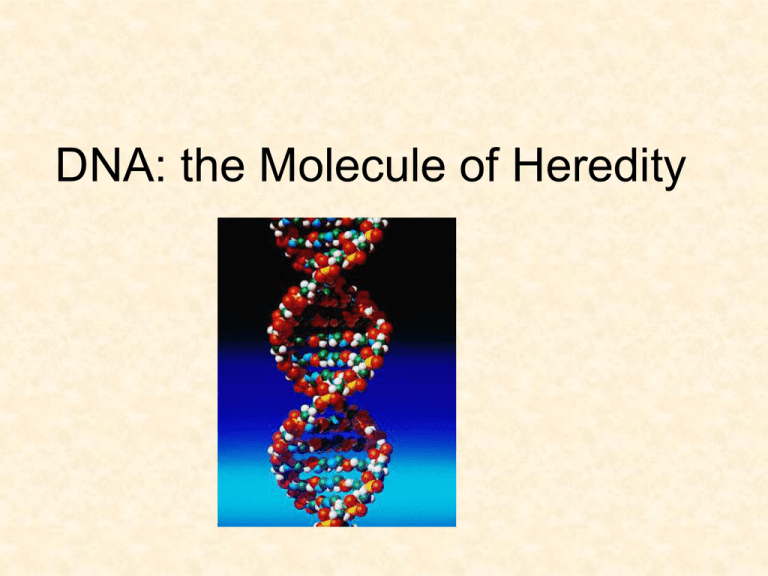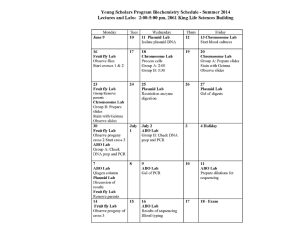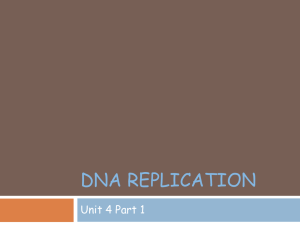
DNA: the Molecule of Heredity
What is DNA?
• Deoxyribonucleic acid
• DNA determines an organism’s traits
• DNA achieves control by producing
proteins
– Remember: proteins give us structural
building material and allow function
(enzymes)
• DNA is the information for life
Time Line – Early History of
Genetics
Key Players
1840’s
Mendel
Place these names and
Early 1900’s T.H. Morgan dates on your timeline
under “Scientists”
1928
Griffith
1944
Avery
1952
Hersey and Chase
1947
Chargaff
Early 1950’s Franklin and Wilkins
Early 1950’s Pauling
1953
Watson and Crick
DNA is the genetic material
• Early 1900’s, the identification of the
molecules of inheritance loomed as a
major challenge to biologists
• T. H. Morgan’s group showed that genes
are located on chromosomes, the two
components of chromosomes—DNA and
protein—became candidates for the
genetic material
Early History of Genetics
• The discovery of the genetic role of DNA
began with research by Frederick Griffith
in 1928
• He worked with two strains of a bacterium,
one pathogenic and one harmless. He did
transformation experiments
• Basically he found that harmless bacteria
became deadly when they took in DNA
from dead pathogenic bacteria
Fig. 16-2
Mixture of
heat-killed
Living S cells Living R cells Heat-killed
S cells and
(control)
(control)
S cells (control) living R cells
EXPERIMENT
Avery - 1944
He separated the
components of the
bacteria and found
only the DNA
extract caused
mice to die
RESULTS
Mouse dies Mouse healthy Mouse healthy Mouse dies
Living S cells
Evidence That Viral DNA Can
Program Cells
• More evidence for DNA as the genetic
material came from studies of viruses that
infect bacteria
• Such viruses, called bacteriophages (or
phages), are widely used in molecular
genetics research
Fig. 16-4-3
Hersey and Chase
EXPERIMENT
Phage
Empty
Radioactive protein
shell
protein
Radioactivity
(phage
protein)
in liquid
Bacterial cell
Batch 1:
radioactive
sulfur (35S)
DNA
Phage
DNA
Centrifuge
Pellet (bacterial
cells and contents)
Radioactive
DNA
Batch 2:
radioactive
phosphorus (32P)
Centrifuge
Pellet
Radioactivity
(phage DNA)
in pellet
Next Steps… What is DNA
made of?
• It was known that DNA is a polymer of
nucleotides, each consisting of a
nitrogenous base, a sugar, and a
phosphate group
• In 1950, Erwin Chargaff reported that DNA
composition varies from one species to the
next, however that the nitrogen based are
found in predictable ratios:
A = T and C = G
Finding the Structure of DNA
• After most biologists became convinced that
DNA was the genetic material, the challenge
was to determine how its structure accounts for
its role
• Maurice Wilkins and Rosalind Franklin were
using a technique called X-ray crystallography
to study molecular structure
• Franklin produced a picture
of the DNA molecule using
this technique
The Discovery of DNA
• Watson and Crick – 1953
– Double Helix – long twisted zipper
Segment with James Watson
Structure of
DNA
• DNA is a long molecule
• Composed of nucleotides
– Simple sugar – deoxyribose
– Phosphate group
– Nitrogen base – Adenine
- Guanine
- Cytosine
- Thymine
DNA Structure Cont.
•
Animation
on how DNA
is packaged
into the
nucleus
S – A ..…T – S
|
|
P
P
|
|
S – G ..…C – S
|
|
P
P
|
|
S – C ..…G – S
|
|
P
P
Weak Hydrogen Bond
A pairs with T
C pairs with G
DNA Instructions for life
• The sequence of nitrogen bases forms the
genetic instructions for an organism
A-T-T-G-A-C
is different than
T-T-C-A-A-G
They code for
different proteins
and therefore
structure and
function of an
organism
How can we use DNA?
• Nucleotide sequences can be used to
determine evolutionary relationships
– Organisms that are closely related have
similar DNA
• Ex. Gorilla and Chimp – very similar
Gorilla and Rose Bush – very different
• It can be used to determine if two people
are related
• DNA can be used to compare DNA from a
crime scene to DNA from a suspect
Complementary Strands
• If one side of the DNA molecule consisted
of the following nucleotide bases, what
would the other side be?
• ATC CTG GAT TAT GAC CAT ATG
DNA Replication
DNA Replication
• You have learned that cells divide through
the process of mitosis and meiosis
• In order to do this, each cell has to make a
copy of its DNA
• DNA is copied through the process of DNA
Replication
• What might happen DNA replication did
not occur prior to cell division?
How DNA Replicates
• Remember: DNA is composed of two
strands
– A pairs with T
– C pairs with G
• So if you know the order of bases on one
side, you know the order on the other side
(the complementary strand)
• During replication, each strand serves as a
pattern
Fig. 16-9-1
A
T
C
G
T
A
A
T
G
C
(a) Parent molecule
*What has to happen first in to make a copy of the DNA?
Fig. 16-9-2
A
T
A
T
C
G
C
G
T
A
T
A
A
T
A
T
G
C
G
C
(a) Parent molecule
(b) Separation of
strands
What type of molecule might help the two sides of the DNA molecule separate?
Fig. 16-9-3
A
T
A
T
A
T
A
T
C
G
C
G
C
G
C
G
T
A
T
A
T
A
T
A
A
T
A
T
A
T
A
T
G
C
G
C
G
C
G
C
(a) Parent molecule
(b) Separation of
strands
What types of molecules might be used to add
nucleotides and bind the sides together?
(c) “Daughter” DNA molecules,
each consisting of one
parental strand and one
new strand
Enzymes involved in DNA
Replication
• Helicase – unwinds the DNA strand to
begin replication
(it’s like unzipping a zipper)
• DNA Polymerase – adds nucleotides, one
at a time to the open DNA strand
(in humans up to 50 nucleotides per second)
• Ligase - joins the sugar-phosphate
backbones of the newly formed strand.
(it’s like gluing the sides together)
Steps of DNA Replication
• Step 1 – An enzyme breaks the H+ bonds
between the nitrogen bases that holds the
two strands together (un-zipping the
molecule)
• Step 2 – Free floating nucleotides in the
cell bond to the complementary bases on
each of the original strands
• Step 3 – An enzyme secures the two
strands together, forming two new chains
DNA Replication Cont.
• DNA replication results in the formation of
two identical strands from the one original
DNA molecule.
What do you think the word
“semiconservative” means?
DNA Replication is
Semiconservative
• Watson and Crick’s semiconservative
model of replication predicts that when a
double helix replicates, each daughter
molecule will have one old strand (derived
or “conserved” from the parent molecule)
and one newly made strand
• DNA replication animation
Animation 2
HHMI animation
Compare the two new strands of DNA. Are
they the same or different? Why?
A
T
A
T
A
T
A
T
C
G
C
G
C
G
C
G
T
A
T
A
T
A
T
A
A
T
A
T
A
T
A
T
G
C
G
C
G
C
G
C
(a) Parent molecule
(b) Separation of
strands
(c) “Daughter” DNA molecules,
each consisting of one
parental strand and one
new strand
From DNA to Protein
From DNA to Protein
• The sequence of nucleotides in DNA
contains information that produces
proteins
• Proteins
– Structures
– Enzymes
• By controlling protein production, DNA
controls cells
RNA
• Different from DNA in
3 ways
– RNA – single strand
– Sugar in RNA is ribose
(DNA = deoxyribose)
– RNA has uricil (U)
instead of thymine
The cell works like a factory
• DNA provides “workers” with instructions
for making proteins
• “workers: bring over the parts (amino
acids) to the assembly line
– Workers = RNA
3 Types of RNA
• Messenger RNA (mRNA)
– brings the info from the nucleus to the factory floor
(cytoplasm)
• Ribosomal RNA (rRNA) – ribosomes are made
of rRNA
– Clamp onto mRNA and use its info to assemble
amino acids
• Transfer RNA (tRNA) – “supplier”
– Transports amino acids to the ribosomes where they
are assembled into proteins
RNA Transcription
• Read steps in figure 11.6 (pg 296)
• Explain how it is different from DNA
replication
• Animation of Transcription
• HHMI animation
The role of tRNA
• For proteins to be built, the 20 different
amino acids dissolved in the cytoplasm
must be brought to the ribosomes
• This is the role of tRNA
tRNA
• Composed of about 80
nucleotides
• Each tRNA only
recognizes only one
amino acid
• The amino acid bonds to
the tRNA
• Located on the base of
the tRNA molecule are
three nitrogen bases,
called an anticodon, that
pair up with an mRNA
codon during translation
tRNA
• Basically, the tRNA molecule transfers the
information for making proteins to the
correct codon on the mRNA.
• If the mRNA has the codon for that
particular amino acid, the tRNA binds, if it
does not, the tRNA doesn’t bind and the
amino acid that the tRNA is carrying is not
made.
Amino Acids to Proteins
• Proteins are made in the Ribosomes
• Proteins are made of Amino Acids
• As multiple tRNA molecules attach to the
mRNA, an enzyme joins the two amino
acids by forming a peptide bond.
Translation of DNA to Protein
• Translation Animation
• HHMI animation
The Genetic Code
• A code is needed to
convert the language
of mRNA into the
language of proteins
amino acids
• There are 20 different
amino acid
• mRNA only has 4
bases (AUCG)
Ala: Alanine
Cys: Cysteine
Asp: Aspartic acid Glu: Glutamic acid
Phe: Phenylalanine Gly: Glycine
His: Histidine
Ile: Isoleucine
Lys: Lysine
Leu: Leucine
Met: Methionine
Asn: Asparagine
Pro: Proline
Gln: Glutamine
Arg: Arginine
Ser: Serine
Thr: Threonine
Val: Valine
Trp: Tryptophane Tyr: Tyrosisne
The Genetic Code Cont.
• Scientist found that
a group of 3
nucleotides codes
for 1 amino acid
• Each set of 3
nucleotides that
code for an amino
acid is called a
codon
The Genetic Code Cont.
• Some codons don’t code for amino acids,
they are instructions for assembling
proteins
– Stop codon = UAA
– Start codon = AUG
Genetic Code Cont.
• All organisms use the same genetic code
for assembling proteins
– UAC = tyrosine in humans, birch trees, and
bacteria
Genetic Code Cont.
Try these:
DNA base
sequence
AAT
GGG
ATA
AAA
GTT
Process
mRNA
codon
Process
tRNA
anticodon
Amino
Acid
Critical Thinking Questions
• How specific are the tRNA molecules?
• How does energy play a role in all this
hustle and bustle?
• How does translation begin and end?
• What happens to the mRNA strands?
Compare and contrast
Transcription and Translation
Transcription
Where?
What is used as a
template?
What is used to
synthesize the
new strand?
What is the new
strand made of?
Translation
Compare and Contrast Replication and Protein Synthesis
Replication
Where?
When?
Purpose?
Starting point?
What enzyme is used to
synthesize the new
strand?
Associated proteins?
Nucleotides?
Finishing Processes?
Where does the
finished “product” go?
Protein Synthesis
Read the Help Wanted ad below. Based on your notes, tell me “who” is
qualified to fill each position. Your choices are DNA, tRNA, and mRNA.
Help Wanted!
• Positions Available in the genetics industry. Hundreds of entrylevel openings for tireless workers. No previous experience
necessary. Must be able to transcribe code in a nuclear
environment. The ability to work in close association with ribosomes
is a must.
• Accuracy and Speed vital for this job in the field of translation.
Applicants must demonstrate skills in transporting and positioning
amino acids. Salary commensurate with experience.
• Executive Position available. Must be able to maintain genetic
continuity through replication and control cellular activity by
regulation of enzyme production. Limited number of openings. All
benefits.
• Supervisor of production of proteins—all shifts. Must be able to
follow exact directions from double-stranded template. Travel from
nucleus to the cytoplasm is additional job benefit.
Central Dogma of Genetics
Genetic Changes
Mutations: Changes in DNA
• Mutation – any change in the DNA
sequence that also changes the protein it
codes for
• Mutations can happen in reproductive cells
and in body cells (cancer)
Point Mutation
• A change in a single base pair in DNA
• Look at this simple analogy
– THE DOG BIT THE CAT
– THE DOG BIT THE CAR
Frameshift Mutation
• When a single base is added or deleted
from a DNA strand
• It shifts the reading of the codons by one
base
More about Mutations
• Look at table 12.3 on pg 346. Gather some
information about the different types of mutations.
Look at the examples of the diseases associated
with each type of mutation
• Read pg 349.
-What are the results of mutations to body cells?
-What are the results of mutations to sex cells?
-Why is a mutation in a sex cell considered
potentially more harmful than one in a body cell?
Chromosomal Mutations
• Changes that occur at the level of the
chromosomes
• Occurs when parts are broken off and lost
during mitosis or meiosis
• Few chromosome mutations are passed
on to the next generation because the
zygote usually dies or is sterile
• Video Clip








